Records of Prime Ministers of the United Kingdom
Records of Prime Ministers of Great Britain and Prime Ministers of the United Kingdom:
Period of service
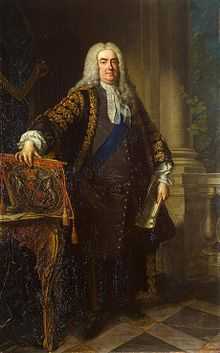
The Prime Minister with the longest single term was Sir Robert Walpole, lasting 20 years and 314 days from 4 April 1721 until 11 February 1742. This is also longer than the accumulated terms of any other Prime Minister.
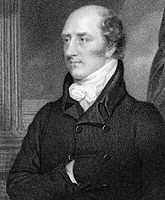
The shortest period in office is more confused, depending on the criteria.
The shortest ever period was only two days, a record held by the Earl of Bath, from 10 February to 12 February 1746, who was asked to form a government but was unable to find more than one person who would agree to serve in his cabinet. A satirist of the time wrote: "the minister to the astonishment of all wise men never transacted one rash thing; and, what is more marvellous, left as much money in the Treasury as he found in it." The 2nd Earl Waldegrave was prime minister for four days, from 8 June to 12 June 1757. However, since neither of these Earls actually formed an effective government, there are other contenders for the record of shortest term of office among those who actually governed the country.
In November 1834, Arthur Wellesley, 1st Duke of Wellington declined to become Prime Minister in favour of Sir Robert Peel but formed a "caretaker" administration for 25 days (17 November 1834 – 9 December 1834) while Peel returned from Europe. However, as a caretaker administration this might not necessarily be considered a term of office in its own right.
Therefore of those with clear and effective terms, the Prime Minister with the shortest single one was Charles Watson-Wentworth, 2nd Marquess of Rockingham, whose second term lasted 96 days from 27 March 1782 until his death on 1 July 1782. However, combined with his first term (13 July 1765 – 30 July 1766) his total time in office was 1 year and 113 days, which exceeds the total periods of several other Prime Ministers. (The Duke of Wellington had also served as prime minister between 1828 and 1830.)
Consequently, the Prime Minister with the total shortest period in office was George Canning, whose sole term lasted 119 days from 10 April 1827 until his death on 8 August 1827.
Other notables
The Prime Minister with the longest period between the start of their first appointment and the end of their final term was William Cavendish-Bentinck, 3rd Duke of Portland, whose first term began on 2 April 1783 and his second and final term ended on 4 October 1809.
Portland also holds the record for the longest period between terms—his first term ended on 19 December 1783 and his second term did not start until 31 March 1807.
Number of terms

A Prime Minister's "term" is traditionally regarded as the period between their appointment and resignation, dismissal (or death, in the case of those who die in office), with the number of general elections taking place in the intervening period making no difference.
The only Prime Minister to serve four terms under that definition was William Ewart Gladstone (3 December 1868 – 20 February 1874, 23 April 1880 – 23 June 1885, 1 February 1886 – 25 July 1886 and 15 August 1892 – 5 March 1894).
Age at appointment
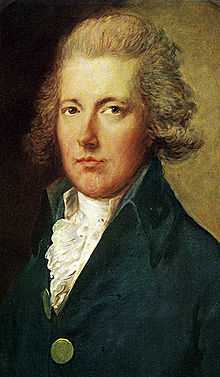
The youngest Prime Minister to be appointed was William Pitt the Younger on 19 December 1783 at the age of 24 years, 6 months and 21 days.
The oldest Prime Minister to be appointed for the first time was Henry John Temple, 3rd Viscount Palmerston on 6 February 1855 at the age of 70 years, 3 months and 17 days.
The oldest Prime Minister to be appointed overall, and oldest to win a General Election, was William Ewart Gladstone, who was born on 29 December 1809 and appointed for the final time on 15 August 1892 at the age of 82 years, 7 months and 3 days, following that year's General Election.
Age on leaving office
The youngest Prime Minister to leave office was Augustus FitzRoy, 3rd Duke of Grafton, who retired in 1770, aged 34. The oldest was Gladstone, who was 84 at the time of his final retirement in 1894.
Longest lived
The longest-lived Prime Minister was James Callaghan, Lord Callaghan of Cardiff, who was born on 27 March 1912 and died on 26 March 2005 at the age of 92 years 364 days, which was the day before his 93rd birthday. Prior to this the longest living Prime Minister was Harold Macmillan, Earl of Stockton, who was born on 10 February 1894 and died on 29 December 1986 (aged 92 years 322 days).
Of the three former Prime Ministers currently alive, the oldest is John Major, who was born on 29 March 1943 and is 72 years old. If he is still alive on 28 March 2036, he will surpass Callaghan's record and become the longest-lived Prime Minister.
Shortest lived
The shortest-lived Prime Minister was William Cavendish, 4th Duke of Devonshire, who was born on 8 May 1720 and died on 2 October 1764 at the age of 44 years and 147 days.
Longest lived after office
The Prime Minister who lived the longest after leaving office for the final time was Augustus FitzRoy, 3rd Duke of Grafton, who left office on 28 January 1770 and died on 14 March 1811, a total of 41 years, 1 month and 17 days.
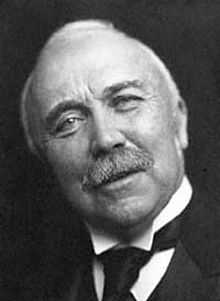
In recent years, the Prime Minister who lived the longest after leaving office was Sir Edward Heath, whose term ended on 4 March 1974; he died on 17 July 2005, 31 years and 135 days later.
Shortest lived after office
The Prime Minister who lived the shortest period after leaving office was Sir Henry Campbell-Bannerman, who resigned on 3 April 1908 and died just nineteen days later on 22 April 1908, while still resident in 10 Downing Street.
Foreign Born Prime Ministers
Only three Prime Ministers have been born outside of the island of Great Britain:
- Both the Earl of Shelburne and the Duke of Wellington were born in Dublin, Ireland before the Union of 1801 (Both had actually served in the Parliament there).
- Bonar Law was born in the colony of New Brunswick in what is now Canada.
General Elections
Most Prime Ministers in office between General Elections
There have been two intervals between General Elections, both in the 18th century, when on both occasions five successive Prime Ministers were in office.
- Between the General Elections of 1761 and 1768: Thomas Pelham-Holles, 1st Duke of Newcastle (resigned 26 May 1762), John Stuart, 3rd Earl of Bute (resigned 8 April 1763), George Grenville (resigned 13 July 1765), Charles Watson-Wentworth, 2nd Marquess of Rockingham (resigned 30 July 1766), and William Pitt, 1st Earl of Chatham (until dissolution of the parliament).
- In the shorter interval between the General Elections of 1780 and 1784: Frederick North, Lord North (resigned 22 March 1782), the 2nd Marquess of Rockingham (second ministry, died in office 1 July 1782), William Petty, 2nd Earl of Shelburne (resigned 2 April 1783), William Cavendish-Bentinck, 3rd Duke of Portland (resigned 19 December 1783), and William Pitt the Younger (until dissolution of the parliament).
In modern times, since members of the House of Lords ceased to hold Prime Ministerial office (after 1902), there were three Prime Ministers in office between the General Elections of 1935 and 1945: Stanley Baldwin (retired 28 May 1937), Neville Chamberlain (resigned 10 May, and subsequently died 1940), and Winston Churchill (until dissolution of the parliament).
Age at losing a General Election
The youngest Prime Minister to be on the losing side at a General Election was Archibald Primrose, 5th Earl of Rosebery, who, having resigned his ministry in May 1895, led his Liberal Party to defeat in the General Election the following month when aged 48. Since peers ceased to hold this office (1902), the youngest losing Prime Minister was John Major, at 54 years and 33 days when the Conservative Party lost the 1997 General Election.
William Ewart Gladstone, was the oldest, at 76 years, when his party lost the 1886 General Election, although he returned to office in 1892. The oldest Prime Minister to be defeated without returning to office was Benjamin Disraeli, 1st Earl of Beaconsfield who was 75 when the Conservative Party lost the 1880 General Election.
Prime Ministers in office without a General Election
Thirteen Prime Ministers have held office without the holding of a General Election in bringing them to office, while holding office, or following the end of their office, usually by serving terms sandwiched between the victor of one election and the one who faced the next. Chronologically they were:
- Spencer Compton, 1st Earl of Wilmington
- William Cavendish, 4th Duke of Devonshire
- John Stuart, 3rd Earl of Bute
- George Grenville
- Augustus Fitzroy, 3rd Duke of Grafton
- Charles Watson-Wentworth, 2nd Marquess of Rockingham (served both his terms electionless)
- William Petty, 2nd Earl of Shelburne
- Spencer Percival
- George Canning
- F. J. Robinson, 1st Viscount Goderich
- George Hamilton-Gordon, 4th Earl of Aberdeen
- Arthur Balfour[1]
- Neville Chamberlain
Prime Ministers who served from, or later entered, the House of Lords
John Russell, a younger son of a Duke of Bedford, was unique in serving one entire term at Downing Street as Commons MP, when known as Lord John Russell (as younger son of a Duke of Bedford) in 1846-52, and his second and last entirely as a member of the Lords as 1st Earl Russell in 1865-66, having been raised to the peerage between terms in 1861.
Without counting Earl Russell, eighteen Prime Ministers served their entire terms from the House of Lords where they were already members, chronologically:
- 1st Earl of Wilmington
- 1st Duke of Newcastle
- 4th Duke of Devonshire
- 3rd Earl of Bute
- 2nd Marquess of Rockingham
- 3rd Duke of Grafton
- 2nd Earl of Shelburne (later 1st Marquess of Lansdowne)
- 3rd Duke of Portland
- 1st Baron Grenville
- 2nd Earl of Liverpool
- 1st Viscount Goderich (later 1st Earl of Ripon)
- 1st Duke of Wellington
- 2nd Earl Grey
- 2nd Viscount Melbourne
- 14th Earl of Derby
- 4th Earl of Aberdeen
- 3rd Marquess of Salisbury
- 5th Earl of Rosebery
Three Prime Ministers were elevated from the Commons to the House of Lords during their terms through being raised to the peerage:
- Sir Robert Walpole, made 1st Earl of Orford 5 days before formally resigning in 1742.
- William Pitt 'the Elder', made 1st Earl of Chatham 5 days after taking his second term office in 1766.
- Benjamin Disraeli, made 1st Earl of Beaconsfield in 1876, two years after taking his second term of office in 1874.
Frederick North, Lord North succeeded to his father's peerage as 2nd Earl of Guildford in 1790 after being in office.
Alec Douglas-Home disclaimed his hereditary peerage (under the Peerage Act of that year) as 14th Earl of Home 4 days after coming to office in 1963, giving up his seat in the Lords and subsequently sat in the Commons after succeeding in a by-election, pending which for 20 days he held office from neither House. He returned to the Lords when made life peer as Baron Home of The Hirsel in 1974.
Eleven Prime Ministers have served their entire terms as Members of the House of Commons but were elevated to the House of Lords afterwards by being created peers:
- Henry Addington became 1st Viscount Sidmouth 1805
- Arthur Balfour became 1st Earl Balfour 1922
- Herbert Henry Asquith became 1st Earl of Oxford and Asquith 1925
- Stanley Baldwin became 1st Earl Baldwin of Bewdley 1937
- David Lloyd-George became 1st Earl Lloyd-George of Dwyfor 1945 (22 years after being Prime Minister)
- Clement Attlee became 1st Earl Attlee 1955
- Anthony Eden became 1st Earl of Avon 1961
- Harold Wilson became Baron Wilson of Rievaulx 1983 (life peer)
- Harold Macmillan became 1st Earl of Stockton 1984
- James Callaghan became Baron Callaghan of Cardiff 1987 (life peer)
- Margaret Thatcher became Baroness Thatcher of Kesteven 1992 (life peer)
In contrast 16 Prime Ministers preceding the current (David Cameron) have never become members of the House of Lords. Henry Pelham (served 1743 to his death in 1754) was the first to be a lifelong 'Commoner' but the convention of Prime Ministers leading from the House of Commons only became established in the 20th century.
Holders of Irish peerages (with the exception of 28 Irish representative peers allowed after 1801, who were elected from among their peers) legally did not sit in the House of Lords in the Parliaments of Great Britain and the United Kingdom, but were allowed to sit in the House of Commons at Westminster. Henry Temple, 3rd Viscount Palmerston was the only Irish peer to serve as Prime Minister, thus leading from the House of Commons.
Number of living former Prime Ministers
None
After Robert Walpole, three other Prime Ministers have been in office at a time when no former Prime Ministers were alive:
- Henry Pelham from the death of Robert Walpole in 1745 until his own death in 1754
- Thomas Pelham-Holles, 1st Duke of Newcastle from the death of Pelham in 1754 until the end of his first term in 1756
- William Gladstone from the death of Disraeli in 1881 until the end of his second term in 1885.
Most
The most living former Prime Ministers at any one time has been 5, which has happened several times: the first time was between January and November 1770, while Lord North was in office, and the Earl of Bute, George Grenville, the 2nd Marquess of Rockingham, Pitt the Elder and the 3rd Duke of Grafton were still alive (Grenville died in November 1770); from 1964 to 1965 with Clement Attlee; Winston Churchill; Anthony Eden; Harold Macmillan; and Alec Douglas-Home the most recent was between November 1990 and May 1995, while John Major was in office, and Douglas-Home, Wilson, Heath, Callaghan and Thatcher were still alive (Wilson died 24 May 1995).
Currently living former prime ministers
There are three living former British Prime Ministers.
- Living former Prime Ministers
-

Sir John Major
KG CH ACIB
served 1990–1997
born 1943 (age 72) -
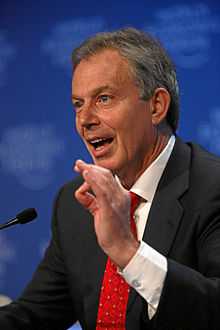
Tony Blair
served 1997–2007
born 1953 (age 61) -
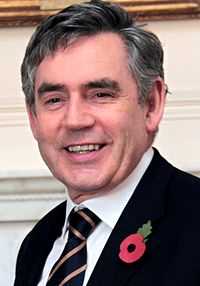
Gordon Brown
MP
served 2007–2010
born 1951 (age 64)
Died in office
Seven Prime Ministers have died in office:
- Spencer Compton, 1st Earl of Wilmington, who died on 2 July 1743, aged 70.
- Henry Pelham, who died on 6 March 1754, aged 59.
- Charles Watson-Wentworth, 2nd Marquess of Rockingham, who died on 1 July 1782, aged 52.
- William Pitt the Younger, who died on 23 January 1806, aged 46, the youngest to die in office.
- Spencer Perceval, who was assassinated by John Bellingham on 11 May 1812, aged 49.
- George Canning, who died on 8 August 1827, aged 57.
- Lord Palmerston, who died on 18 October 1865, aged 81 years (less two days), the oldest to die in office.
Spencer Perceval is the only British Prime Minister to have been assassinated.
Sir Henry Campbell-Bannerman and Bonar Law each resigned during their respective final illnesses. Law died five months after his resignation, but Campbell-Bannerman lived only another 19 days, dying at 10 Downing Street, the only Prime Minister ever to do so. Another who died within the same year he was Prime Minister was Neville Chamberlain, who died in 1940, six months (less a day) after he left office, of a cancer that was undiagnosed at the time of his resignation.
Widowed
Widowed the longest
- The British Prime Minister widowed the longest is Archibald Primrose, 5th Earl of Rosebery who died more than 38 years after his wife.
- Recently, the British Prime Minister widowed the longest is Harold Macmillan, who was widowed from 21 May 1966 to his death on 29 December 1986, a total of over 20 years.
Widowed the shortest
The British Prime Minister widowed the shortest is James Callaghan, who died on 26 March 2005. His wife, Audrey Callaghan, died on 15 March 2005, only 11 days before him.
Other widowed Prime Ministers
- Sir Robert Walpole (twice widowed)
- George Grenville
- Earl of Shelburne (twice widowed)
- Henry Addington
- Earl of Liverpool (remarried)
- Duke of Wellington
- Viscount Melbourne
- Lord John Russell (remarried)
- Earl of Aberdeen (twice widowed)
- Benjamin Disraeli
- Marquess of Salisbury
- Sir Henry Campbell-Bannerman
- Herbert Henry Asquith (remarried)
- David Lloyd George (remarried)
- Andrew Bonar Law
- Stanley Baldwin
- Ramsay MacDonald
- Clement Attlee
- Sir Alec Douglas-Home
- Baroness Margaret Thatcher
Kindred Prime Ministers
Fathers and Sons
Two sets of father and son have held the office:
- William Pitt, 1st Earl of Chatham (aka "Pitt the Elder") and William Pitt the Younger
- George Grenville and William Grenville, 1st Baron Grenville.
Brothers
The only brothers to hold the office were Henry Pelham, who was succeeded on his death in 1754 by Thomas Pelham-Holles, 1st Duke of Newcastle.
Full cousins
Pitt the Younger and Baron Grenville (who directly succeeded the latter in office) were the only set of full cousins holding the office, their fathers being brothers-in-law.
Uncles and Nephews
There have been three blood uncle-nephew sets of Prime Ministers:
- William Pitt, 1st Earl of Chatham and William Grenville, 1st Baron Grenville
- George Grenville and William Pitt the Younger
- Robert Gascoyne-Cecil, 3rd Marquess of Salisbury and Arthur Balfour, who succeeded Salisbury in office after the latter's last term. The phrase "Bob's your uncle" is said to have originated in connection with this set, from ministerial promotions Balfour gained under Salisbury.[2][3]
Brothers-in-law
Pitt the Elder was married from 1754 to George Grenville's sister Hester, making themselves the only set of brothers-in-law to hold the office.
Uncle-in-law and Nephew-in-law
Winston Churchill and Anthony Eden. In 1952, during Churchill's second term, Eden married Clarissa, daughter of John Strange Spencer Churchill, Winston's brother, before succeeding to the office.
Miscellaneous
The Prime Minister who had the most children is Charles Grey, 2nd Earl Grey, who fathered 17 children.
The tallest Prime Minister is believed to be Lord Salisbury, who was around 6 feet 4 inches (1.93 m) in height,[4] although Downing Street's own website lists 6-foot-1-inch (1.85 m) James Callaghan as the tallest.[5]
The shortest period between entering Parliament and being appointed Prime Minister was William Pitt the Younger who became Prime Minister two years after first becoming an MP. The longest period of service as an MP before becoming Prime Minister was 47 years for Lord Palmerston.
The richest Prime Minister was Edward Smith-Stanley, 14th Earl of Derby, with a personal fortune of over £7 million (about £444 million in today's money).[6] The poorest was William Pitt the Younger, who was £40,000 (now over £1 million) in debt by 1800.
See also
- List of Prime Ministers of the United Kingdom by longevity - includes age at beginning of first term
- List of UK monarchy records
- List of Prime Ministers of the United Kingdom by term length
- List of UK Parliament constituencies represented by sitting Prime Ministers
References
- ↑ Balfour resigned on 5 December 1905 but was immediately succeeded by his then Liberal opponent, Campbell-Bannerman, who did not call the next General Election until January 1906.
- ↑ Trahair, R. C. S. (1994). From Aristotelian to Reaganomics: A Dictionary of Eponyms With Biographies in the Social Science. Greenwood Publishing Group. p. 72. Retrieved 30 July 2012.
- ↑ Bernstein, Jonathan (2006). Knickers in a Twist: A Dictionary of British Slang. Canongate U.S. p. 65. Retrieved 4 August 2012.
- ↑ Englefield, Dermot; Janet Seaton; Isobel White (1995). Facts About the British Prime Ministers. Mansell. p. 374.
- ↑ "James Callaghan". 10 Downing Street.
- ↑ "Richest British Prime Minister". guinnessworldrecords.com. Retrieved 12-04-2013. Check date values in:
|accessdate=(help)
| |||||||||||||||||||||||||||||
.svg.png)